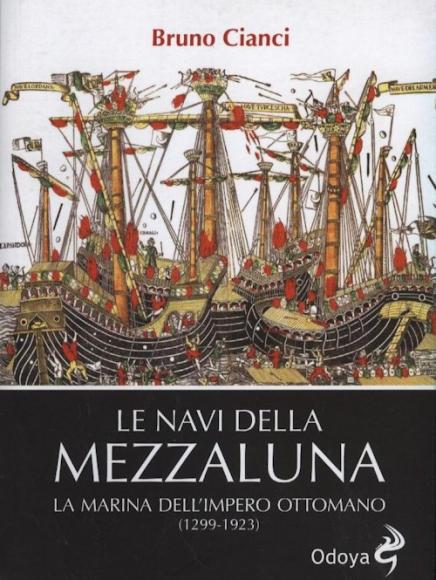Bruno Cianci
Ed. Odoya, Bologna 2015
pagg.391
The author, journalist and historian, with a wealth of details, describes the history of the Ottoman navy in this extensive essay - whose draft took seven years of work. "Although descending from an unequivocally earthly people, the Ottomans could count on a centuries-old naval tradition, developed within the Turkish empire that had dominated Anatolia before the advent of Osman and his progeny: the Seljuks," (dynasty that fell in the thirteenth century, thus giving space to the Ottomans) that, to protect from raiders the west coast of Anatolia, terminus of the Silk Road, they felt the need, both commercial and military, to arm ships.
The conquest of Constantinople, of the 1453, took place with a fleet of about one hundred / one hundred and ten war units of various tonnages, for a total of troops that went from the 80.000 to the 160.000 men, and with a part of the ships that, by order of the Sultan Mehemet II, was transported by land to bypass the fortified walls of the Genoese colony of Galata. A navy, that of Mehemet II, used as an auxiliary force to the army of land and consists of caiques, fuste, galeotte and galee.
With the ascent to the throne of Beyazit II, which occurred in 1481 at the death of Mehemet II, there was a strong development of the navy, with the adoption of ever larger galleys, which led to the decline of Venice in the Levant, making the Ottomans undisputed masters of continental Greece and Albania "Making the myth of Christian invincibility on the sea anachronistic".
In the sixteenth century, where "Turkish and Islamic culture and wisdom merged with the Renaissance of the European courts" there was also the development of cartography. The map of the Atlantic Ocean of Piri Reis dates back to 1513, which is also the oldest Turkish document on which the American continent is based. But the sixteenth century also saw the exploits of the two corsairs, the brothers Oruç and Hizir Barbarossa, and the ascent to the throne, to the death of Selim, of the sultan Suleiman the Magnificent who, with the conquest of Rhodes, obtained the safety of the routes and of trade in the Levant. "With the exception of Cyprus, for which Venice paid a salty annual tax, the Mediterranean became an Ottoman lake in all respects."
Appointed commander in chief of the Ottoman navy, Hizir Barbarossa (his brother had died in combat), lord of Algiers, devoting himself to the preparation of the fleet, "Over the years it became an all-round expert in radbobbo, maintenance and naval architecture." On the Italian and Spanish coasts, attacked by pirates and barbarian pirates, sighting towers began to emerge while Carlo V hired Admiral Andrea Doria to oppose the Ottoman fleet. A contrast not always determined, that of Andrea Doria, perhaps because Charles V was more interested in weakening the naval power of the Republic of San Marco than to beat the Turks. The common aversion to Charles V of France and Spain, however, encouraged the birth, in the 1543, of the impious alliance between Francis I and Suleiman the Magnificent, an alliance that allowed Barbarossa to have, for some years, at his disposal, the naval base of Toulon. Three years later, the 4 July 1546, Barbarossa died due to violent dysentery. His legacy was subsequently collected by the famous Dragut, protagonist, in the 1565, of the siege of Malta, which cost him his life.
An important year was the 1571 where the Ottomans, despite obtaining the island of Cyprus, the main objective of the war in Venice, they came out substantially defeated, because of the battle of Lepanto occurred the 7 October. Soon after, however, under the guidance of Uluç Alì Reis - Calabrian renegade - nominated kapudan paşa, the rebirth of the Ottoman fleet was organized in a few months. Due to the failure of the siege of Malta and the Lepanto disaster, "The sixteenth century ended with a substantial setback due to the expansionist vocation of the Ottoman empire which" ceased to be interested in the western half of the Mediterranean and left it under the control of the Barberia regencies ", that is to say those of Algiers, Tunis and Tripoli, which based their economy mainly on running and that "They had already carved out a certain degree of autonomy from Istanbul, while continuing to formally form part of the Ottoman Empire."
With the seventeenth century there was the affirmation of the galleons on the galleys. In the 18th century, the last naval battle between the Ottomans and the Venetians took place in 1718, in Cape Tenaro (Matapan). With the peace of Passarowitz of 21 July 1718 began the decline of the Serenissima - the only Italian state not subjected to Spanish rule - that "From 1718 to 1797, the year of his fall at the hands of Napoleon, he was no longer involved in major conflicts." Since then, for the Ottomans, the new enemy was represented by the Tsar fleet. The main desire of Peter I Romanov (1672-1725), called the Great, was that of constituting a powerful navy of war and of conquering the outlets on which to make it operate. Russian access to the Baltic Sea, in fact, was precluded by Sweden while "The Black Sea and the Sea of Azov were equally inaccessible, being firmly in the hands of the Ottomans or the khanati their vassals." Therefore the search for an outlet to the southern seas led to contrasts between Istanbul and Moscow from the 1695 onwards, contrasts also due to the fact that "Istanbul, the Constantinople of Orthodox Christians, was seen by the Russians as a city to be returned, sooner or later, to Christianity."
The first historical Russian success on the Turks was the 28 July 1696 with the conquest of Azov. From the 1739 to the 1769 there was a period of peace between Russia and the Ottomans, a period marked by a kind of lethargy of the Ottoman navy that made him lose ground compared to the Russian navy. The peace was interrupted by the battle of Çeşme where, the 7 July 1770, with the almost total annihilation of the fleet, the loss of 12.000 cannons and the death of 7.000 Turks, the most terrible tragedy in the history of the Ottoman navy, after Lepanto . The effects of this disaster "Forced the Ottomans to a renewal that invested not only the military sphere, but also the administrative, bureaucratic, fiscal", renewal which, for the navy, took place with the contribution of foreign nations, such as France and Sweden, and which concerned shipbuilding, shipyards and personnel education. In the galleons, the stern and bow castles disappeared, while copper was used to cover the hulls. Despite, however, these efforts made by the sultan Selim III, "The decline of the Ottoman navy started in Lepanto, which was repeatedly blocked and resurfaced in all its drama in the Çeşme bay, could not be said to have been arrested."
The Battle of Navarino - the largest Turkish base in the Peloponnese - fought the 20 1827 October and where the fleet of a Franco-Russian-English coalition eradicated the Ottoman one, was dramatic for the Turkish empire as it accelerated the loss of Greece - sanctioned the 21 July 1832 with the Treaty of Constantinople - and produced a profound bill between Egypt and Istanbul. Meanwhile, the Sultan decided to give impetus to the construction of steam ships instead of sailing and, subsequently, in the 1852, to the introduction of the propeller as a means of propulsion instead of paddle wheels.
After the catastrophe of Sinope (1853) and after the Crimean War (1854-1856) the wooden hulls were definitively decommissioned and the metal armor was introduced, much more suitable to resist the grenades fired by the new generation cannons. Between the end of the 19th and the beginning of the 20th century there were two main innovations introduced in the naval field: a new type of military ship, the destroyer and a new weapon, the torpedo. The 16 January 1878 Turkish steam ship Intibah was the first ship sunk in a war action by an autonomous torpedo.
We arrived at the Great War where, of the forty ships that the Turkish navy had, eight were destroyers. At the end of the Great War "Ten million people were gone, as were four glorious empires: Ottoman, German, Austro-Hungarian and Russian."
29 October 1923 was formally established in the Republic of Turkey, led by Mustafà Kemal, who assumed the name of Kemal Atatürk (father of the Turks), and that, with the Treaty of Lausanne of 24 July 1923 obtained inter alia, thanks to its prestige, to keep in being a war fleet.
Gianlorenzo Capano












